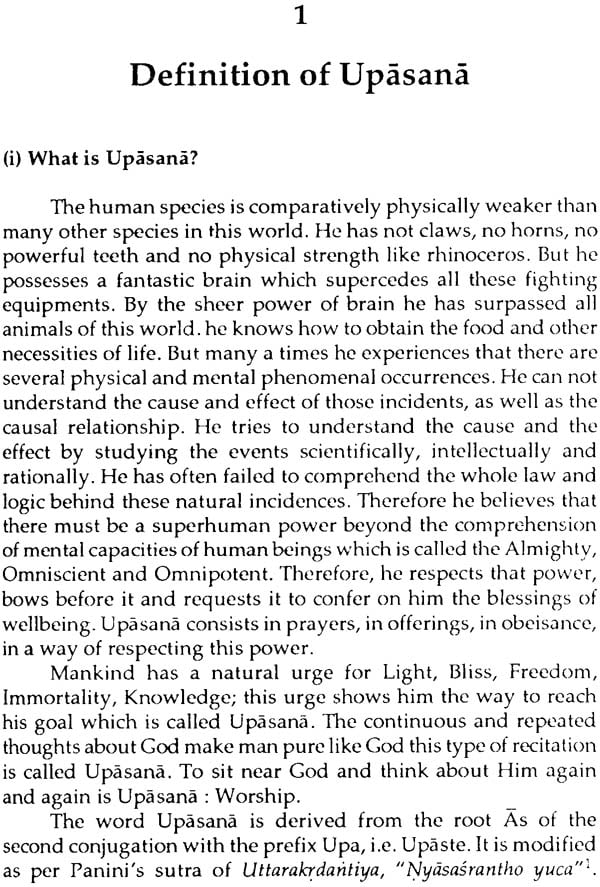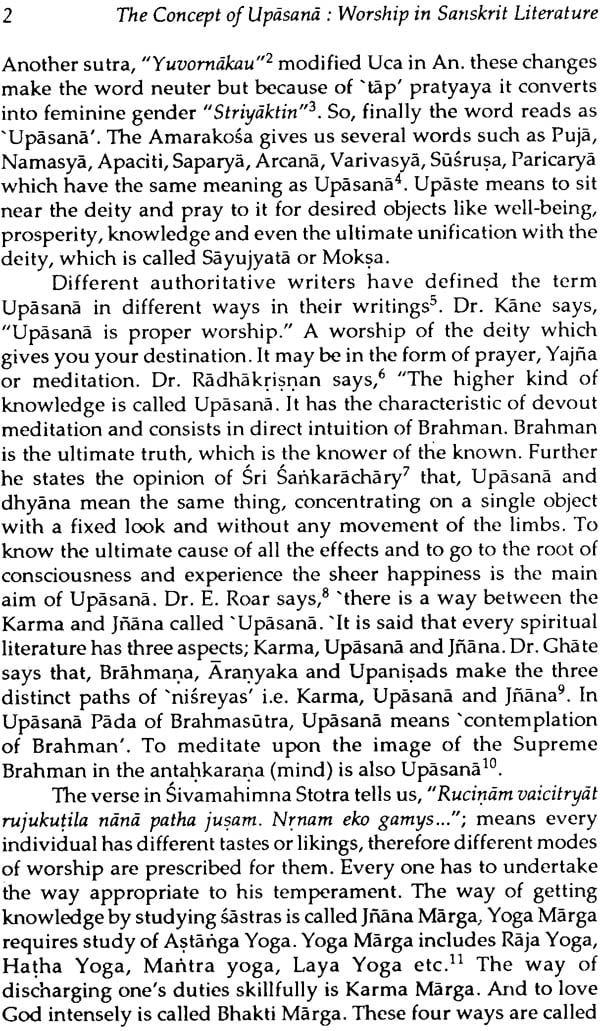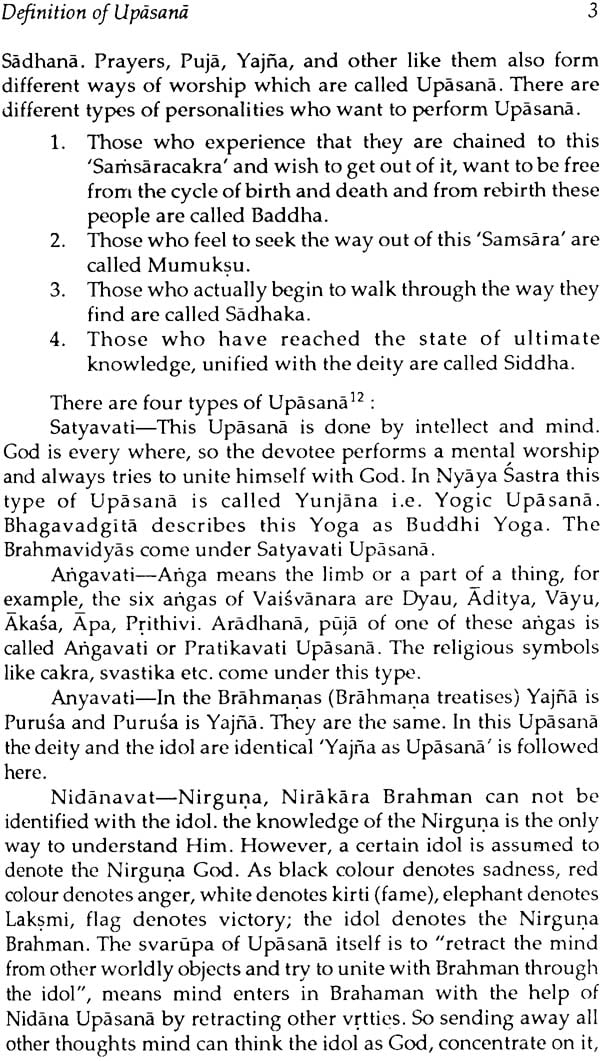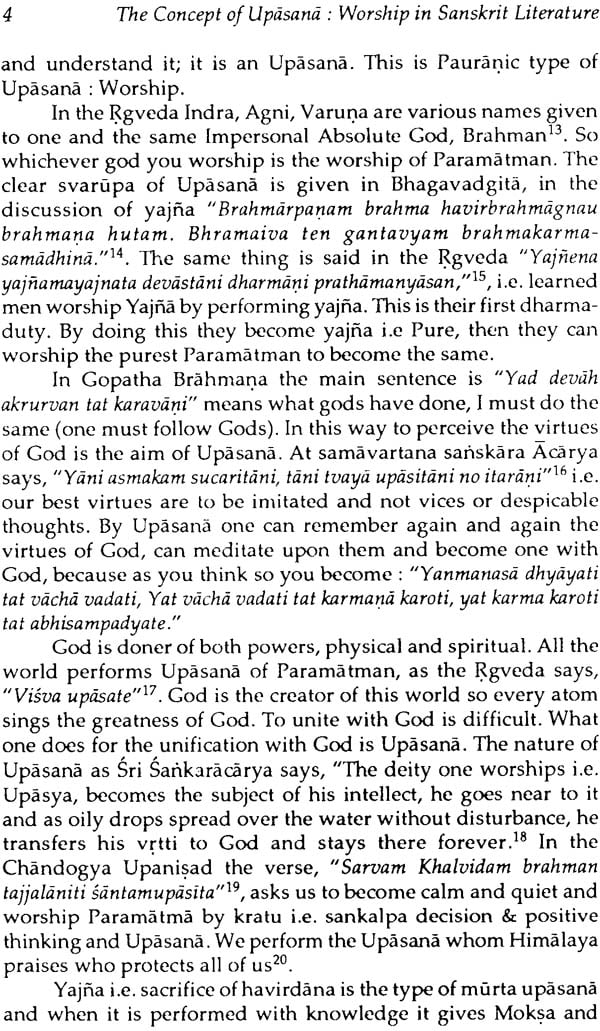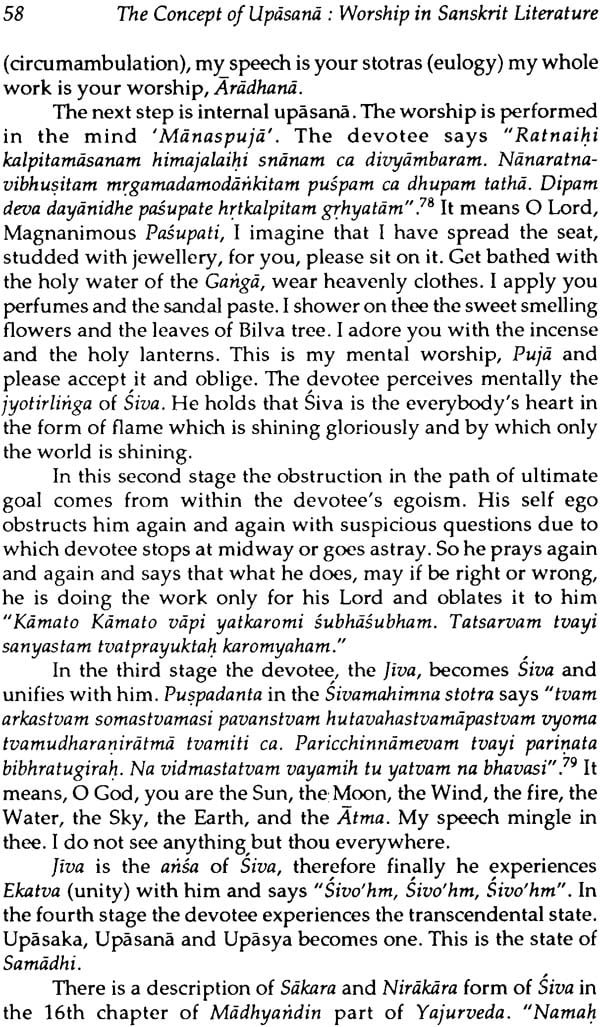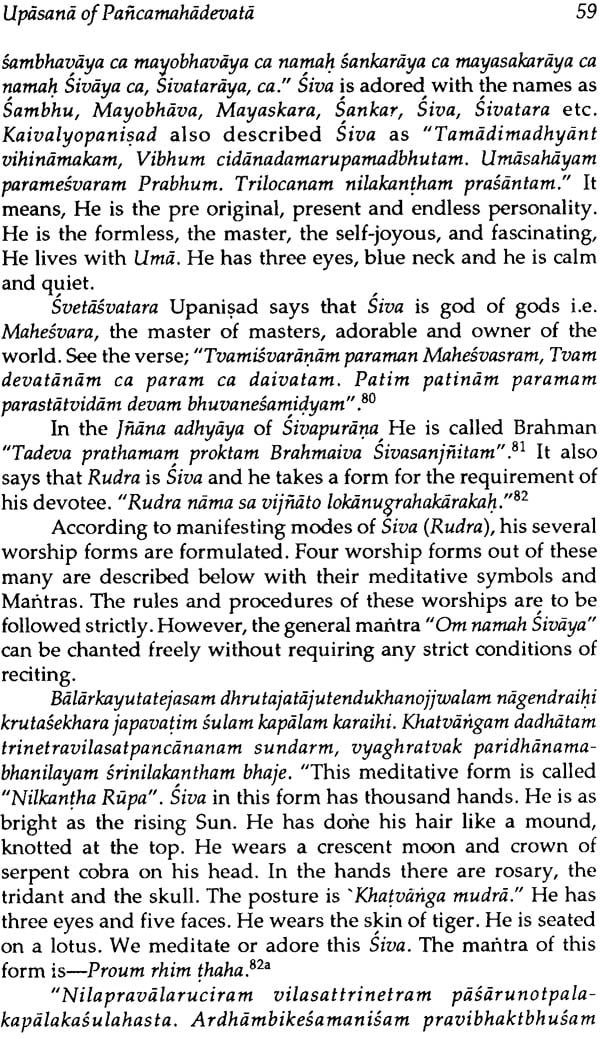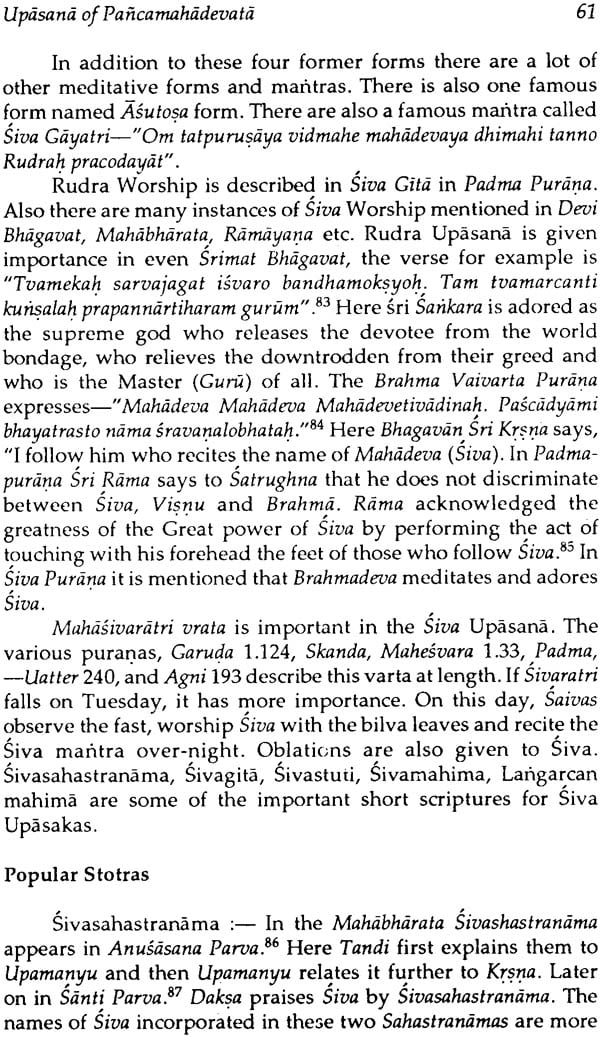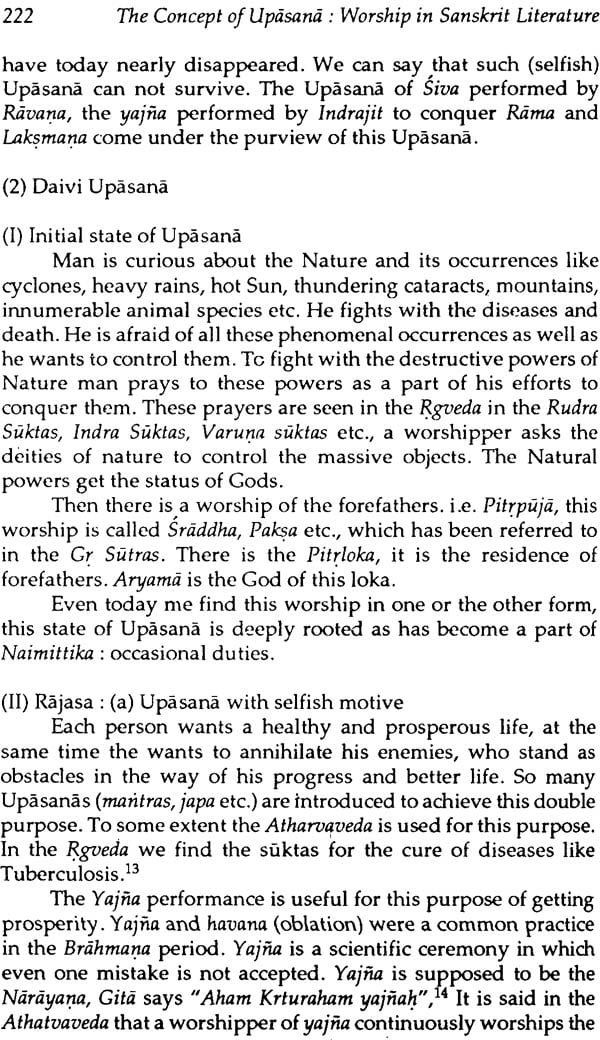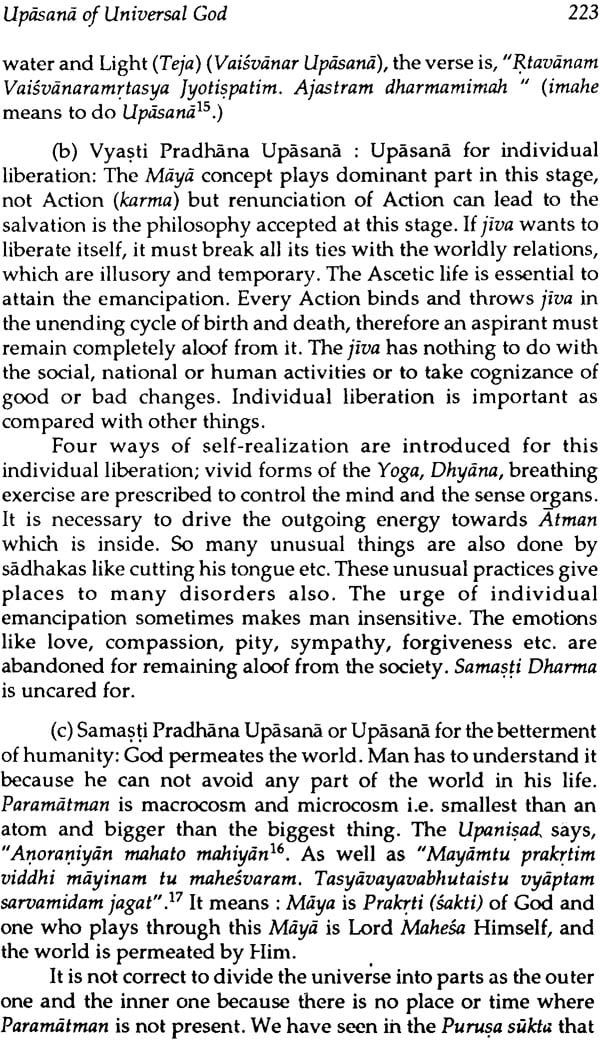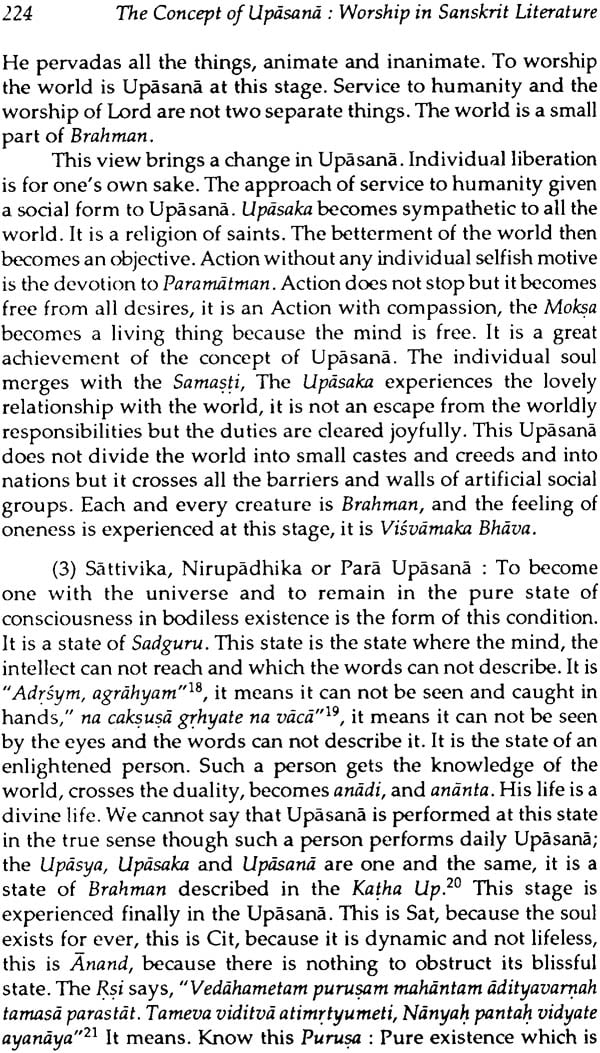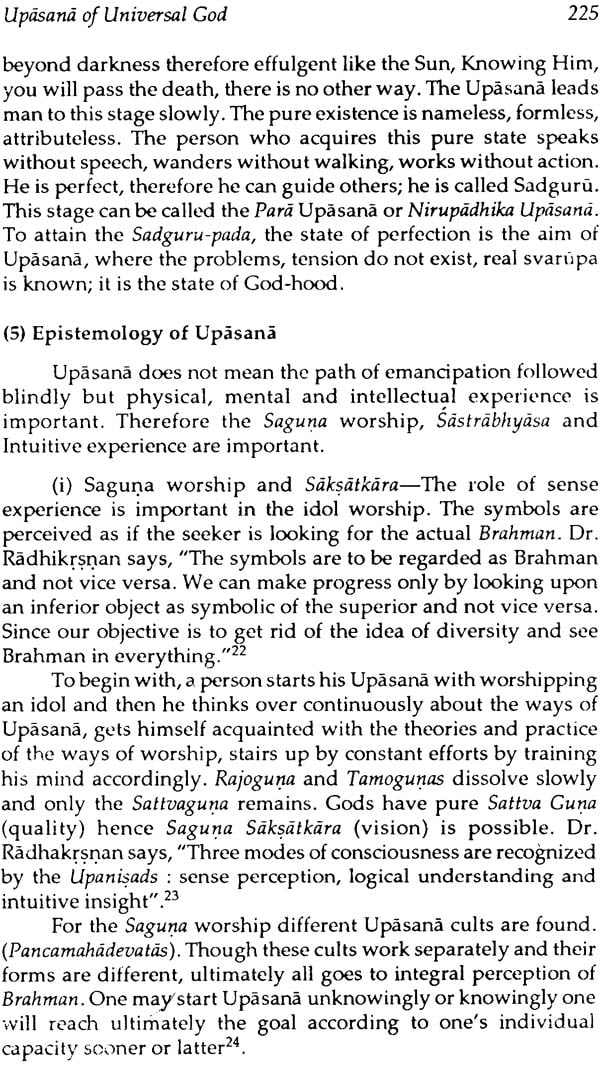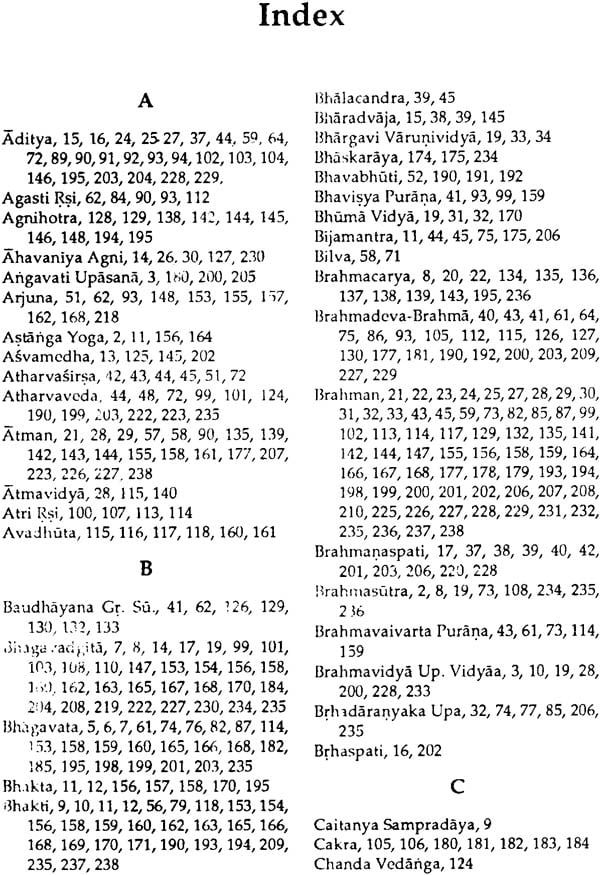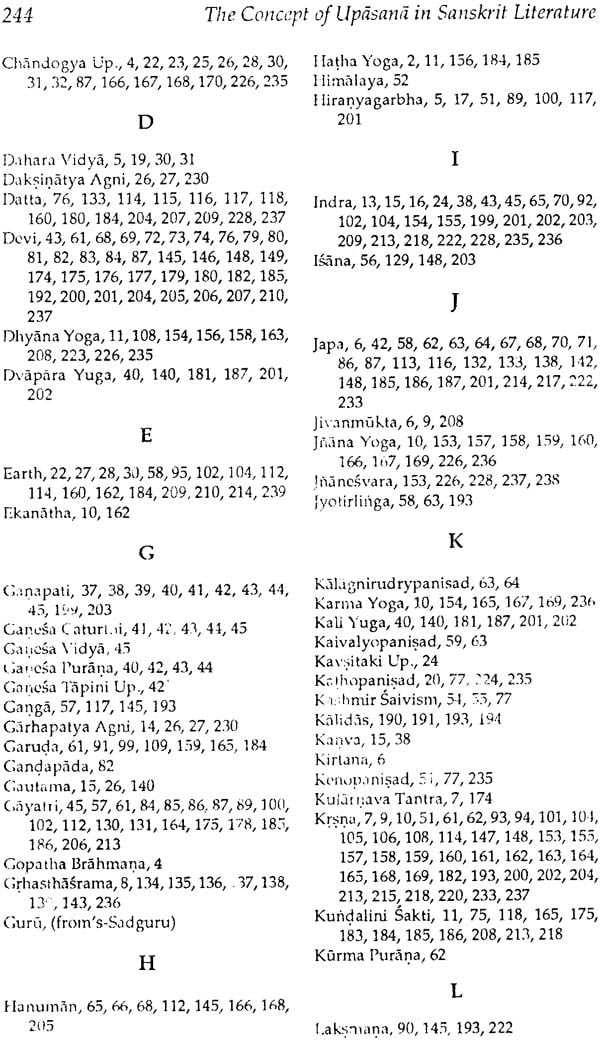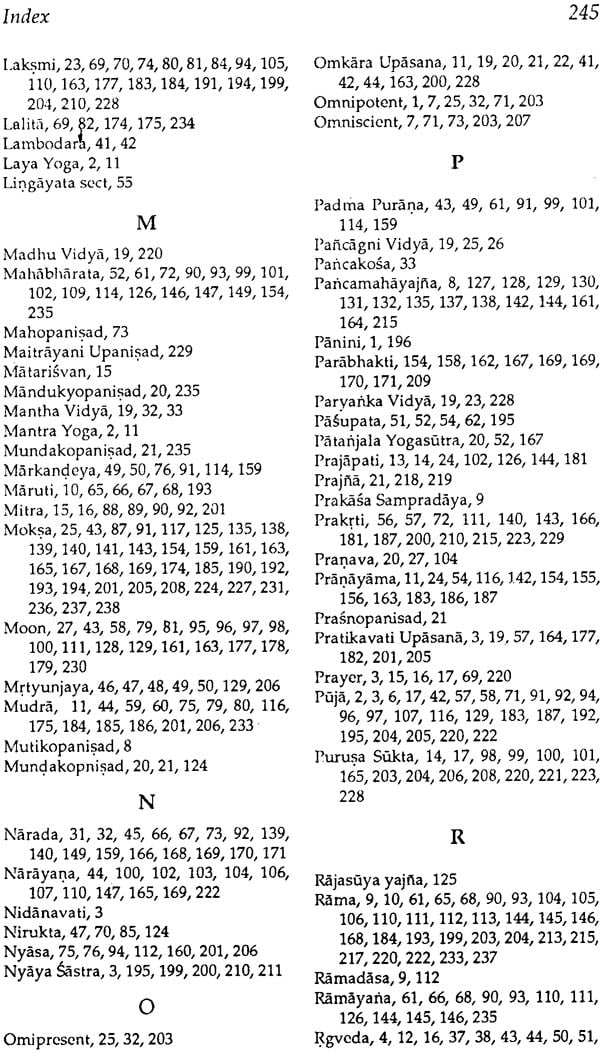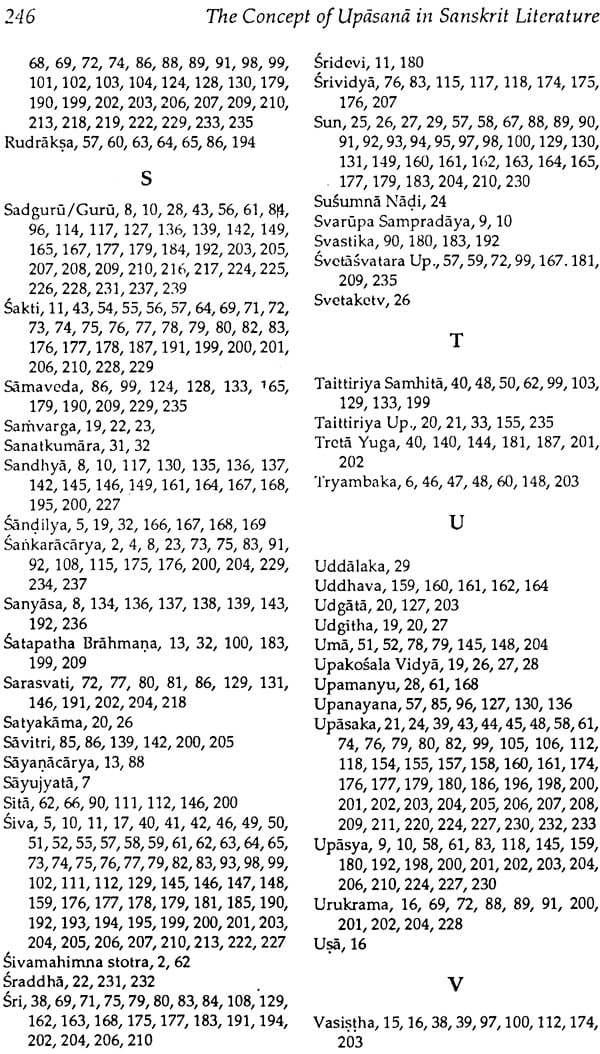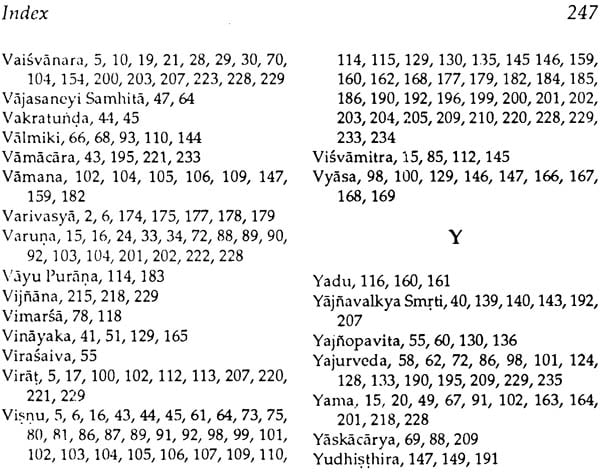
The Concept of Upasana : Worship in Sanskrit Literature
Book Specification
| Item Code: | IDI559 |
| Author: | Rajani S. Patki |
| Publisher: | Sri Satguru Publications |
| Edition: | 1996 |
| ISBN: | 8170304830 |
| Pages: | 264 |
| Cover: | Hardcover |
| Other Details | 8.6" X 5.5 |
| Weight | 480 gm |
Book Description
Preface
It is my pleasure that the expected study discussed in the 'Introduction' of this book has been completed in Jan. 1993 and the University of Bombay has awarded me the Degree of Ph. D. for the said work in the same year. Now the thesis is being published in the book-form by the well-known publishing house: "Indian Books Centre" Delhi. For the convenience of the publication the thesis is modified. I hope, this book will help the scholars in their research field and the devotees in their progress towards emancipation and the service to the mankind and the Nature as well.
I offer my humble regards to Dr. N. A. Deshpande, my guide for Ph. D. for his constant guidance and help throughout the entire work. I have completed my study of Ph. D. in Ananthacharya Indological Research Institute, Colaba, Bombay. I am thankful to Dr. K. K. A. Venkatachari, the then Director of the Institute for rendering me all kinds of help during my Study. I am thankful to H. H. Swami Purushottamananda Sarasvati (Acharya of Chinmaya Mission) for certain suggestions made by Him and His blessings to this work. I am thankful to Dr. P. P. Apte for offering the 'Foreword' to this book. I am thankful to the officers and staff of 'Indian Books Centre' for their prompt response in publishing my book, 'The Concept of Upasana : Worship in Sanskrit Literature'.
May the Almighty Omniscient, Omnipotent and Omnipresent God Dattatreya Confer happiness on the readers.
Foreword
It gives me pleasure to write this foreword to the book 'The Concept o Upasana : worship in Sanskrit Literature' written by Dr. Mrs. Rajani S. Patki. I happened to be an evaluator of her Ph. . Thesis submitted to the Bombay University. In my report I had observed that "The outline of the structure of the thesis deserves compliments for thought and planning on the part of the candidate and the guide. The data collected by the candidate is of wide utility for the research field. The conclusion part of the thesis should reflect and it does so the contribution of the candidate. The candidate has neatly arranged the topics as: Meaning of Upansana, Aspects of Upansana : Physical, Psychological and Intellectual, Forms of Upasana-practices: Nature Worship, Social Religion, and Methods of Upasana : Asuri, Daivi etc. the other topics covered by the candidate are : Epistemology, Concept of god and Religion as implicit in Upasana, Mysticism in Upasana and Philosophy in Upasana. The arrangement and treatment of these topics by the candidate are adequate enough to adjudicate the thesis fit for Ph. D. Degree.
At that time I had made some suggestions for making the thesis fit for publication. Now after two years the press copy is shown to me by Dr. Mr. Rajani Patki with a happy news that it is being published by prestigious publisher like Indian books Centre, Delhi. During this short interval I find that Dr. Mrs. Patki has undertaken a strenuous job to convert the thesis into a welcome book form. I had also occasions to attend her series of lectures on august audience of Gita Dharma Mandal, Pune. In fact I was profusely thanked by the organizes as well s eminent members of the audience for introducing her as a speaker to Gita Dharma Mandal, Pune. I feel proud to recommend this publication to the readers belonging to religio-spiritual as well as research field. I hope it will be widely received by the readers on the strength of its intrinsic merit.
The great heritage of Indian culture is a mix of much diversity, religion forming the strongest element. The next element of equal strength, wisdom and profundity is Sanskrit Literature. In this book a constructive survey of the available relevant Sanskrit Literature is proposed to throw light on this literature to understand the concept of Upasana: Worship and the salient features of this concept which given rise to the richness of Bhakti literature and the tradition of saints in India. The objective of this book is to study the diverse forms of Upasana as they are developed; unity among these forms and the continuity they present throughout the cultural history. An attempt has been made to study the following literary forms to understand the concept of Upasana : Worship as implicit in them which together give us rather than an adequate reference frame. For the sake of convenience the study follows the following classification.
Vedic - The Rgveda, Yajurveda, Samaveda, Atharvaveda,
Upanisadic - 10 Main Upanisads, Minor Upanisads.
Pauranic - 18Main Puranas, Minor Puranas.
Agama - Saivagarna, Saktagama, Vaisnavagama.
Srnrti - Manu Smrti, other smrtis.
Itihasa - Rarnayana, Mahabharata.
Sutra - Brahmasutra, Kalpasutra, Bhaktisutra.
Special- Bhagavadgita, Srimadbhagavatam.
Forms of literature - Drama, Prose, Poetry.
Much as the cultural life is diverse, there is a thread of unity which binds all other diverse elements or ways of worship. We may call it Hindu Dharma which itself means the great under- standing of the Vedic religion or Vedic Sanatana Dharma. Corresponding to the diverse customs and languages, are the different ways of worship or Updsarui, Vedic religion contains hundreds of Upasanas which appearing differently are in essence the same, i.e. they aim at understanding the nature of self and the 'Universe' first per se and also as an inter-related phenomenon. The diversity of Upasana methods are therefore natural and are individually chosen for their suitability. Each individual is different by nature, his physical, psychological and intellectual capacity is also different. Srutis state that the spheres of animate and inanimate are nothing but Paramataman, though we do not understand this fact because of our ignorance. But each one is capable of unifying with Him and to have His knowledge, and one can advance to that unification according to one's own capacity and in one's own way. Therefore Upasana methods naturally vary according to individuals.
In the Rgveda, the Rsis thought that Natural phenomena have some divine forces behind them. These forces are personified into many gods, and they also think that all these are the aspects of one and the same all pervading Brahman which manifests itself in various forms. The worshipper prays to these gods for his welfare by pouring oblation into fire i.e. Yajna. Man wants a vision of his ideal; therefore, he starts to worship idols, (personified Gods), in the name and form, with some virtues attached to them. According to choices of different persons gods vary in number and so their idols. The worship method takes different forms according to individual capacity and nature.
Efficacy of Upasana
In general the life span of a person is divided into four stages i.e. Asramas : Brahmacarya, in which studentship is covered: Grhasthasrama, in which household life is covered; Vanaprasth- asrama, in which the renunciation is prescribed with meditation and worship and, Sanyasasrama, in which the throwing away of Worldly bondages and unity with God is expected. Paramatman is worshipped in different ways in each of the Asramas, which is related to Asramadharma.
There is another classification of human beings: The fourfold system of Cestes-Brahmana, Ksatriva, Vaisya and Sudra. The three qualities of primordial Nature (Prakrti) are Sattva, Raja and Tama. Pure sattva quality is not present in human beings unless they reach Godhood. More quantity of Sattva and less of the other two is the nature of Brahmana; Sattva and Raja are normally equal in the nature of Ksatriva. Rajas is more prominent than the other two in the nature of Vaisya and Tama is greater than the other two in the nature of Sudra. Each person acts according to his nature. These Upasanas vary to the capacity and nature of a person in Varnasramadharma. This book discusses the diversity of Upasana : Worship and tries to trace out the concept of Upasana: Worship in Sanskrit literature.
| Foreword | vii |
| Preface | ix |
| Introduction | xiii |
| Ch. I - Definition of Upasana | 1 |
| (i) What is Upasana? | |
| (ii) Upasana, Sadhana and Bhakti. | |
| (iii) Yajna as Upasana. | |
| (iv) What is a Prayer? | |
| Ch. II - Upanisadic Upasana : Brahmavidyas | 19 |
| (i) Udgitha Vidya | |
| (ii) Samvarga Vidya | |
| (iii) Paryanka Vidya | |
| (iv) Madhu Vidya | |
| (v) Pancagni Vidya | |
| (vii) Upakosala Vidya | |
| (viii) Dahara Vidya | |
| (ix) Bhuma Vidya | |
| (x) Sandilya Vidya | |
| (xi) Mantha Vidya | |
| (xii) Bhargavi Varuni Vidya | |
| Ch. III - Upasana of Pancamahadevata | 37 |
| (i) Ganapati: Vedic Later Ganapati Upasana. Sects. Popular stotras | |
| (ii) Siva Upasana : Vedic Later Siva Upasana. Sects. Popular Stotras Hanuman Upasana. | |
| (iii) Sakti Upasana: Vedic Later Sakti Upasana, Sects Popular Stotras | |
| (iv) Surya Upasana : Vedic Later Surya Upasana, Sects. Popular Stotras, Navagraha Upasana. | |
| (v) Visnu Upasana : Vedic Later Visnu Upasana, Sects Popular Stotras Rama Upasana Datta Upasana | |
| Ch. IV - Upasana in Kalpasutra, Smrti and Epic Literature | 124 |
| Part I - Upasana in Kalpasutra | |
| (i) Upasana in Srautasutra | |
| (ii) Upasana in Grhyasutra | |
| (iii) Upasana in Dharmasutra | |
| Part II - Upasana in Smrti Literature | |
| Part III - Upasana in Epic Literature | |
| (i) Upasana in the Ramayana | |
| (ii) Upasana in the Mahabharata. | |
| Ch. V - Upasana in the Bhagavadgita, Srimad-bhagavatam, and the Bhaktisutras | 153 |
| (i) Upasana in the Bhagavadgita | |
| (ii) Upasana in the Srimdbhagavatam | |
| (iii) Upasana in the Bhakti Sutras | |
| (a) Upasana in the Sandilya Bhakti Sutras | |
| (b) Upasana in the Narada Bhakti Sutra | |
| Ch. VI - The Tantrika Upasana and Upasana with Symbols | 174 |
| Part I - Tantrika Upasana | |
| Part II - Upasana with Symbols | |
| (i) Diagrams | |
| (ii) Mudras | |
| (iii) Structures | |
| Ch VII - Upasana in Classical Sanskrit Dramas, Poetry and Prose | 190 |
| Ch. VIII - Upasya, Upasana and Upasaka | 198 |
| Ch. IX - Upasana of Universal God | 213 |
| English Transliteration Code for Sanskrit Phonems | 241 |
| Index | 243 |
